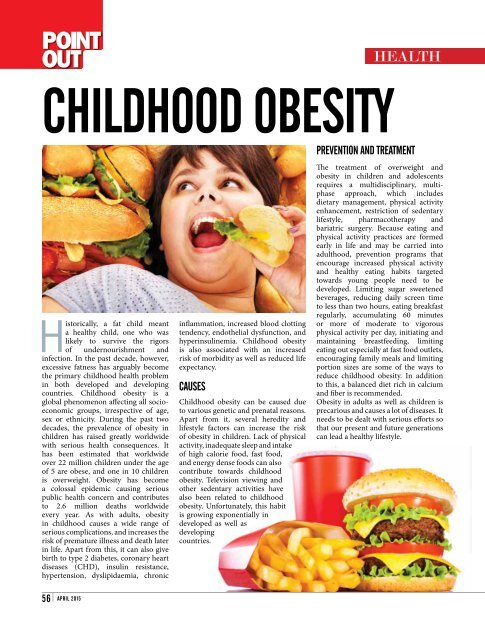You also want an ePaper? Increase the reach of your titles
YUMPU automatically turns print PDFs into web optimized ePapers that Google loves.
POINT<br />
OUT<br />
HealtH<br />
chIldhood obesIty<br />
H<br />
istorically, a fat child meant<br />
a healthy child, one who was<br />
likely to survive the rigors<br />
of undernourishment and<br />
infection. In the past decade, however,<br />
excessive fatness has arguably become<br />
the primary childhood health problem<br />
in both developed and developing<br />
countries. Childhood obesity is a<br />
global phenomenon affecting all socioeconomic<br />
groups, irrespective of age,<br />
sex or ethnicity. During the past two<br />
decades, the prevalence of obesity in<br />
children has raised greatly worldwide<br />
with serious health consequences. It<br />
has been estimated that worldwide<br />
over 22 million children under the age<br />
of 5 are obese, and one in 10 children<br />
is overweight. Obesity has become<br />
a colossal epidemic causing serious<br />
public health concern and contributes<br />
to 2.6 million deaths worldwide<br />
every year. As with adults, obesity<br />
in childhood causes a wide range of<br />
serious complications, and increases the<br />
risk of premature illness and death later<br />
in life. Apart from this, it can also give<br />
birth to type 2 diabetes, coronary heart<br />
diseases (CHD), insulin resistance,<br />
hypertension, dyslipidaemia, chronic<br />
inflammation, increased blood clotting<br />
tendency, endothelial dysfunction, and<br />
hyperinsulinemia. Childhood obesity<br />
is also associated with an increased<br />
risk of morbidity as well as reduced life<br />
expectancy.<br />
causes<br />
Childhood obesity can be caused due<br />
to various genetic and prenatal reasons.<br />
Apart from it, several heredity and<br />
lifestyle factors can increase the risk<br />
of obesity in children. Lack of physical<br />
activity, inadequate sleep and intake<br />
of high calorie food, fast food,<br />
and energy dense foods can also<br />
contribute towards childhood<br />
obesity. Television viewing and<br />
other sedentary activities have<br />
also been related to childhood<br />
obesity. Unfortunately, this habit<br />
is growing exponentially in<br />
developed as well as<br />
developing<br />
countries.<br />
PreventIon and treatMent<br />
The treatment of overweight and<br />
obesity in children and adolescents<br />
requires a multidisciplinary, multiphase<br />
approach, which includes<br />
dietary management, physical activity<br />
enhancement, restriction of sedentary<br />
lifestyle, pharmacotherapy and<br />
bariatric surgery. Because eating and<br />
physical activity practices are formed<br />
early in life and may be carried into<br />
adulthood, prevention programs that<br />
encourage increased physical activity<br />
and healthy eating habits targeted<br />
towards young people need to be<br />
developed. Limiting sugar sweetened<br />
beverages, reducing daily screen time<br />
to less than two hours, eating breakfast<br />
regularly, accumulating 60 minutes<br />
or more of moderate to vigorous<br />
physical activity per day, initiating and<br />
maintaining breastfeeding, limiting<br />
eating out especially at fast food outlets,<br />
encouraging family meals and limiting<br />
portion sizes are some of the ways to<br />
reduce childhood obesity. In addition<br />
to this, a balanced diet rich in calcium<br />
and fiber is recommended.<br />
Obesity in adults as well as children is<br />
precarious and causes a lot of diseases. It<br />
needs to be dealt with serious efforts so<br />
that our present and future generations<br />
can lead a healthy lifestyle.<br />
56<br />
aPrIl <strong>2015</strong>
















